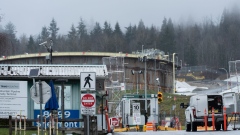Nov 26, 2021
B.C. solicits firms to rebuild flood-ravaged highways
, Bloomberg News
British Columbia has begun soliciting companies to help rebuild highways ravaged by one of the worst floods on record in the western Canadian province even as impending storms threaten to hinder recovery efforts.
The province is seeking requests for qualifications from construction and engineering firms to reconstruct two heavily damaged roads, Highway 8 and Highway 1 -- the latter a part of the Trans-Canada, the country’s main coast-to-coast highway system.
“When we rebuild, we will rebuild better than it was,” Transportation Minister Rob Fleming told reporters Friday. “Our infrastructure will be rebuilt to withstand the new climate realities that we find ourselves in.”
British Columbia, a major conduit to Asia and home to Canada’s largest port, is in a state of emergency after a so-called once-in-a-century storm washed away chunks of highways and shut down the tracks of both major railways, cutting off the region by land from the rest of the country for days. Thousands were evacuated, fuel sales have been rationed in the Vancouver region, and more animals have died, adding to this year’s grim count: a record heat wave five months earlier killed more than 650,000 livestock.
A fresh set of storms, known as an atmospheric river, is passing through the region again with the worst set to hit on Tuesday, threatening to trigger more flooding and hamper efforts to restore rail and road links. Fleming warned of potential power outages in the days ahead.
The Nicola River, a major tributary in the interior which had flowed alongside Highway 8, carved out a new path during the recent deluge, washing away bridges and some five kilometers of roadways, Fleming said.
The coastal region is accustomed to rain at this time of the year: on average, Vancouver gets only 60 hours of measurable sunshine during the entire month of November. But the volume of water this year has blown through historical records -- in some areas, by as much as five times. The storm system was so powerful that it passed over mountain ranges that typically block precipitation and keep the interior of the province dry.







